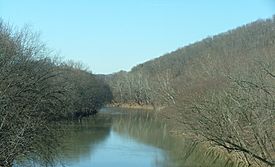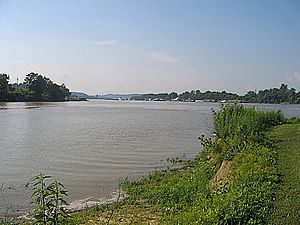Big Sandy River (Ohio River tributary) facts for kids
Quick facts for kids Big Sandy River |
|
|---|---|

Confluence of Levisa Fork and Tug Fork, forming the Big Sandy River
|
|

Map of the Big Sandy River watershed, with its Levisa Fork (left) and Tug Fork (right) tributaties shown
|
|
| Country | United States |
| State | Kentucky, West Virginia |
| Counties | Lawrence KY, Wayne WV, Boyd KY |
| Physical characteristics | |
| Main source | Tug Fork Big Stone Ridge, McDowell County, WV 2,604 ft (794 m) 37°16′38″N 81°26′06″W / 37.27722°N 81.43500°W |
| 2nd source | Levisa Fork Gap of Sandy, Buchanan County, VA 2,657 ft (810 m) 37°09′06″N 81°54′04″W / 37.15167°N 81.90111°W |
| River mouth | Ohio River Catlettsburg, KY 525 ft (160 m) 38°24′58″N 82°35′45″W / 38.41611°N 82.59583°W |
| Length | 29 mi (47 km) |
| Basin features | |
| Basin size | 4,057 sq mi (10,510 km2) |
The Big Sandy River is a river in the United States. It is about 29 miles (47 km) long. This river flows through western West Virginia and northeastern Kentucky. It forms part of the border between these two states for its entire length.
The Big Sandy River is a tributary of the Ohio River. This means it flows into the Ohio River. The Ohio River then flows into the Mississippi River. So, the Big Sandy River is part of the huge Mississippi River watershed.
Contents
What is the Big Sandy River?
The Big Sandy River starts where two other rivers meet. These are the Tug Fork and the Levisa Fork. They join together between Louisa, Kentucky, and Fort Gay, West Virginia. From there, the Big Sandy River flows mostly north. It winds a lot, like a snake, between Lawrence and Boyd counties in Kentucky, and Wayne County in West Virginia.
The river finally joins the Ohio River. This happens between Catlettsburg, Kentucky and Kenova, West Virginia. This spot is about 8 miles (13 km) west of Huntington, West Virginia. It is also where West Virginia, Kentucky, and Ohio meet.
Why is it called Big Sandy?
The river gets its name from the many sand bars found along its path. These are large areas of sand built up in the river. Native American groups had different names for the river. Some of these names included Tatteroa, Chatteroi, and Chatterwha. The name "Big Sandy" was used by at least 1789. An early settler named David White, who lived near the river, had a tombstone from 1817 that mentioned he lived near the "Mouth of the Big Sandy."
How is the River Used?
The Big Sandy River is navigable. This means boats can travel on it. It is used for commercial shipping. The main cargo carried on the river is coal. This coal is mined in the areas nearby.
Cultural Connections
The Big Sandy River is famous in music and history. Two well-known fiddle songs are named after it: "Sandy River Belle" and "Big Sandy River." Famous singers like Loretta Lynn in her song "Van Lear Rose" and Dwight Yoakam in "Bury Me" also mention the river.
The river also played a role in the famous Hatfield–McCoy feud. This was a long-running disagreement between two families. Some Native American tribes, such as the Tutelo, Issa, and Cherokee, lived in or had connections to this region.
Environmental Event: Martin County Spill
On October 11, 2000, a large environmental event happened near the Big Sandy River. This was called the Martin County sludge spill. A storage area for coal waste, owned by Massey Energy, broke open. This waste flowed into an old underground mine. From there, it polluted hundreds of miles of the Ohio River, the Big Sandy River, and its smaller streams.
The waste contained harmful substances like heavy metals. These included mercury, lead, arsenic, copper, and chromium. The spill was very large, much bigger than the Exxon Valdez oil spill. The U.S. Environmental Protection Agency called it one of the worst environmental events in the southeastern United States.
See also
 In Spanish: Río Big Sandy (río Ohio) para niños
In Spanish: Río Big Sandy (río Ohio) para niños


